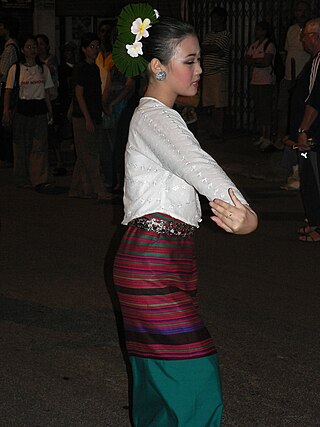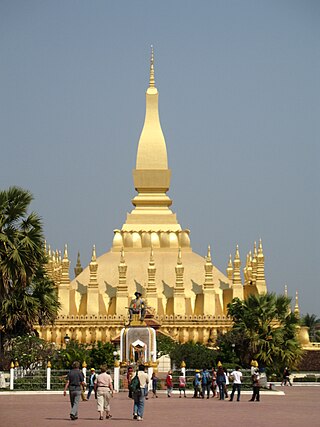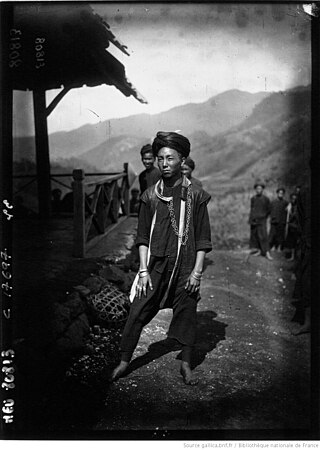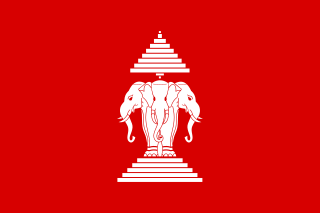
Laos, officially the Lao People's Democratic Republic, is the only landlocked country in Southeast Asia. At the heart of the Indochinese Peninsula, Laos is bordered by Myanmar (Burma) and China to the northwest, Vietnam to the east, Cambodia to the southeast, and Thailand to the west and southwest. Its capital and largest city is Vientiane.

The Hmong people are an indigenous group in East and Southeast Asia. In China, the Hmong people are classified as a sub-group of the Miao people. The modern Hmong reside mainly in Southwest China and countries in Southeast Asia such as Vietnam, Laos, Thailand, and Myanmar. There is also a large diasporic community in the United States of more than 300,000. The Hmong diaspora has smaller communities in Australia and South America.

The Lao people are a Tai ethnic group native to Southeast Asia, who speak the Lao language of the Kra–Dai languages. They are the majority ethnic group of Laos, making up 53.2% of the total population. The majority of Lao people adhere to Theravada Buddhism. They are closely related to other Tai people, especially with the Isan people, who are also speakers of Lao language, native to neighboring Thailand.

Chao Anouvong, or regnal name Xaiya Setthathirath V, , led the Lao rebellion (1826–28) as the last monarch of the Kingdom of Vientiane. Anouvong succeeded to the throne in 1805 upon the death of his brother, Chao Inthavong, Xaiya Setthathirath IV, who had succeeded their father, Ong Bun or Phrachao Siribounyasan Xaiya Setthathirath III. Anou was known by his father's regal number until recently discovered records disclosed that his father and brother had the same regal name.

The Northern Thai people or Tai Yuan, self-designation khon mu(e)ang are a Tai ethnic group, native to nine provinces in Northern Thailand, principally in the area of the former kingdom of Lan Na. As a Tai group, they are closely related to Tai Lü and Tai Khün with regards to common culture, language and history as well as to Thailand's dominant Thai ethnic group. There are approximately 6 million Tai Yuan. Most of them live in Northern Thailand, with a small minority 29,442 living across the border in Bokeo Province of Laos. Their language is called Northern Thai, Lanna or Kham Mueang.

Vang Pao was a major general in the Royal Lao Army and later a leader of the Hmong American community in the United States.
Wat Tham Krabok is a Buddhist temple (wat) in the Phra Phutthabat District of Saraburi Province, Thailand.

Laos developed its culture and customs as the inland crossroads of trade and migration in Southeast Asia over millennia. As of 2012 Laos has a population of roughly 6.4 million spread over 236,800 km2, yielding one of the lowest population densities in Asia. Yet the country of Laos has an official count of over forty-seven ethnicities divided into 149 sub-groups and 80 different languages. The Lao Loum have throughout the country's history comprised the ethnic and linguistic majority. In Southeast Asia, traditional Lao culture is considered one of the Indic cultures.

Theravada Buddhism is the largest religion in Laos, which is practiced by 66% of the population. Lao Buddhism is a unique version of Theravada Buddhism and is at the basis of ethnic Lao culture. Buddhism in Laos is often closely tied to animist beliefs and belief in ancestral spirits, particularly in rural areas.

Pa Chay Vue,, commonly referred to as Pa Chay or Batchai, led the Hmong people in the War of the Insane revolt against French rule in French Indochina from 1918 to 1921. He was considered a hero among the Hmong nationalists, but regarded as a crazed man among the French-subdued Hmong, but in present times, he is unanimously considered a national hero.

Pa Kao Her was an ethnic Hmong born in Nong Het District, Xieng Khouang Province, northern Laos, near the border with Vietnam. He was one of the first followers of his cousin, Shong Lue Yang, also known as the "Mother of Writing", who developed the Pahawh script. Later, he was one of the leaders of the Hmong ChaoFa movement in Laos, along with Zong Zoua Her, after the communist Lao People's Revolutionary Party took power in 1975. He was President of the Ethnic Liberation Organization of Laos (ELOL), an anti-Lao PDR government organization based in Thailand, with a presence in Laos, in the 1980s. Later, he became president of the ChaoFa Democratic Party.

The Royal Lao Government in Exile (RLGE) is a Laotian government in exile opposed to the Lao People's Democratic Republic established on May 6, 2003, and seeks to reinstall a constitutional monarchy in Laos. The RLGE also seeks to end what it sees as the Vietnamization of Laos and the Lao-Viet special Brotherhood Treaty. It was headed by then Prime-minister Khamphoui Sisavatdy and King Soulivong Savang.

A wat is a type of Buddhist temple and Hindu temple in Cambodia, Laos, East Shan State, Yunnan, the Southern Province of Sri Lanka and Thailand. The word wat was borrowed from Sanskrit vāṭa, meaning 'enclosure'. The term has varying meanings in each region, sometimes referring to a specific type of government-recognised or large temple, other times referring to any Buddhist or Hindu temple.

Muang Sing is a small town and district (muang) in Luang Namtha Province, northwestern Laos, about 60 kilometres northwest of the town of Luang Namtha and 360 kilometres northwest of Vientiane. It lies very close to the border with Yunnan, China, surrounded by mountains and rivers. Historically, Muang Sing has been a major producer of opium and still has problems with drugs and smuggling, due to its proximity to China and Myanmar.

Thiền Buddhism is the Vietnamese version of Zen Buddhism. Thiền is the Sino-Vietnamese pronunciation of the Middle Chinese word 禪 (chán), an abbreviation of 禪那 (chánnà), which is a transliteration of the Sanskrit word dhyāna ("meditation").
The people of Laos have a rich literary tradition dating back at least six hundred years, with the oral and storytelling traditions of its peoples dating back much earlier. Lao literature refers to the written productions of Laotian peoples, its émigrés, and to Lao-language works. In Laos today there are over forty-seven recognized ethnic groups, with the Lao Loum comprising the majority group. Lao is officially recognized as the national language, but owing to the ethnic diversity of the country the literature of Laos can generally be grouped according to four ethnolinguistic families: Lao-Tai (Tai-Kadai); Mon-Khmer (Austroasiatic); Hmong-Mien (Miao-Yao), and Sino-Tibetan. As an inland crossroads of Southeast Asia the political history of Laos has been complicated by frequent warfare and colonial conquests by European and regional rivals.
Hmong writing refers to the various writing systems that have been used for transcribing various Hmongic languages, spoken by Hmong people in China, Vietnam, Laos, the United States, and Thailand, these being the top five countries. Over a dozen scripts have been reported for Hmong, none of which is considered standard for transcribing the languages in the eyes of the speakers.
Ban Vinai Refugee Camp, officially the Ban Vinai Holding Center, was a refugee camp in Thailand from 1975 until 1992. Ban Vinai primarily housed highland people, especially Hmong, who fled communist rule in Laos. Ban Vinai had a maximum population of about 45,000 Hmong and other highland people. Many of the highland Lao were resettled in the United States and other countries. Many others lived in the camp for years which came to resemble a crowded and large Hmong village. The Royal Thai Government closed the camp in 1992, forced some of the inhabitants to return to Laos and removed the rest of them to other refugee camps.














